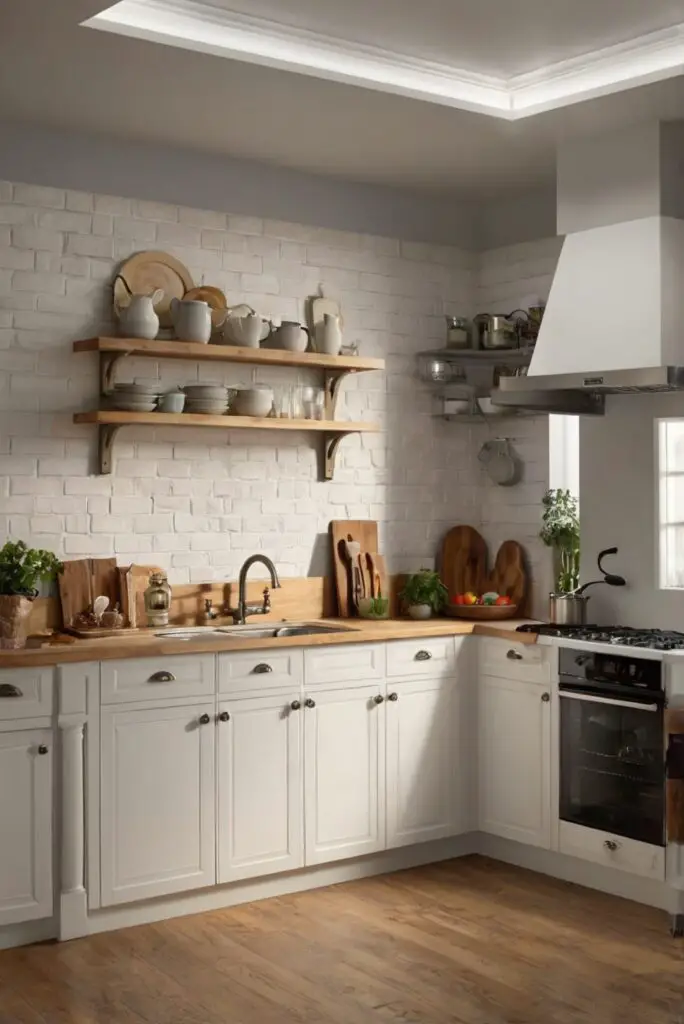Looking to transform your kitchen with the perfect shade of white? Discover expert tips for selecting the ideal hue to elevate your kitchen walls.
How do you choose the right shade of white for your kitchen walls?
White is a versatile color for kitchen walls, but choosing the right shade can be tricky. As an interior designer, it is essential to consider factors such as lighting, existing decor, and personal preference. Opt for warm whites to create a cozy atmosphere or cool whites for a sleek look. Experiment with sample pots to test the color in different lighting conditions. Consider the undertones of the white paint to ensure it complements the kitchen’s color scheme. Remember, white reflects light, making the kitchen appear brighter and more spacious. Stay organized by creating a color palette or using color matching tools for a cohesive look.
What is the best white paint color for dark kitchen cabinets?
Choosing the right white paint color for dark kitchen cabinets is crucial to create a balanced and harmonious space. One of the best white paint colors for dark kitchen cabinets is “Chantilly Lace” by Benjamin Moore. It is a crisp, clean white with no undertones, making it a versatile option that complements dark cabinets beautifully. Another popular choice is “Decorator’s White” by Benjamin Moore, which is a classic, bright white that works well in modern kitchens with dark cabinets. When selecting a white paint color, consider the overall ambiance and style you want to achieve in your kitchen.
Can I use different shades of white in my kitchen walls?
My Lovely Spring Paint for 2025
Ready for a Spring Makeover? Explore the Freshest 2025 Paint Trends!
White Sage/Green SW Pistachio green Soft blue Honeysweet/Orange Pink Sugar Sage Tint BMAs an Amazon Associate, I may earn a commission from qualifying purchases at no extra cost to you.
Yes, you can use different shades of white in your kitchen walls to create depth and visual interest. Mixing various white hues can add dimension to the space and prevent it from looking flat or sterile. Consider using a warm white on one wall and a cooler white on another to create a subtle contrast. Just make sure the different shades of white you choose complement each other and create a cohesive look in your kitchen.
How do I determine the undertones of white paint for my kitchen walls?
Determining the undertones of white paint is essential to avoid clashes with your existing decor and ensure a harmonious look in your kitchen. To identify the undertones of white paint, consider the lighting in your kitchen. Natural light can affect how the paint looks, so test samples in different lighting conditions. Additionally, compare the white paint samples to other elements in your kitchen, such as countertops and cabinets, to determine if they have warm, cool, or neutral undertones.
Can I mix various white hues in the same room for a cohesive look?
Mixing various white hues in the same room can create a visually interesting and cohesive look, but it requires careful consideration of undertones and lighting. To ensure a harmonious mix of white hues, select shades that have similar undertones. Avoid mixing warm whites with cool whites, as they may clash. Test paint samples on different walls in the room to see how they interact with each other and the existing decor. By paying attention to undertones and lighting, you can successfully mix various white hues for a cohesive look.
What alternative paint colors can I consider for a modern kitchen besides white?
My fAV Spring DECOR for 2025
Discover Spring’s Best 2025 Decor Combinations – Perfect for Any Room!
Oversized Indoor Plants White Curved Sofas Rugs BOH Brown Cream Moroccan Hype Boho Rug Outdoor Patio Furniture Sets Topfinel Pillow CoversAs an Amazon Associate, I may earn a commission from qualifying purchases at no extra cost to you.
While white is a popular choice for modern kitchens, there are alternative paint colors that can give your space a fresh and stylish look. Consider using light gray or greige tones for a contemporary feel that complements dark cabinets. Soft pastel colors like pale blue or mint green can add a pop of color without overwhelming the space. Darker hues like navy or charcoal can create a bold, sophisticated look in a modern kitchen. Experiment with different paint colors to find one that suits your style and complements your dark cabinets.
How do I choose the right sheen level for white paint in a high-traffic kitchen?
Choosing the right sheen level for white paint in a high-traffic kitchen is essential to ensure durability and ease of maintenance. For high-traffic areas like kitchens, a semi-gloss or satin finish is recommended for white paint. These finishes are easier to clean and more resistant to stains and moisture than flat or eggshell finishes. Semi-gloss and satin sheens also reflect more light, making the space feel brighter. Consider the level of maintenance you are willing to commit to when selecting the sheen level for white paint in your kitchen.
What are some tips for incorporating white into my kitchen decor while keeping it from looking sterile?
To incorporate white into your kitchen decor without making it look sterile, consider the following tips:
– Add texture: Introduce textured elements like wood, metal, or natural fibers to break up the white and add warmth to the space.
– Use accents: Incorporate pops of color through accessories, such as colorful kitchen utensils, rugs, or artwork, to add visual interest.
– Mix finishes: Combine different finishes like matte and glossy surfaces to create depth and add dimension to the white-dominated space.
– Greenery: Bring in indoor plants or fresh flowers to add life and freshness to the kitchen, balancing the white color scheme.
– Statement lighting: Install statement light fixtures that create focal points in the kitchen and add character to the white backdrop.







